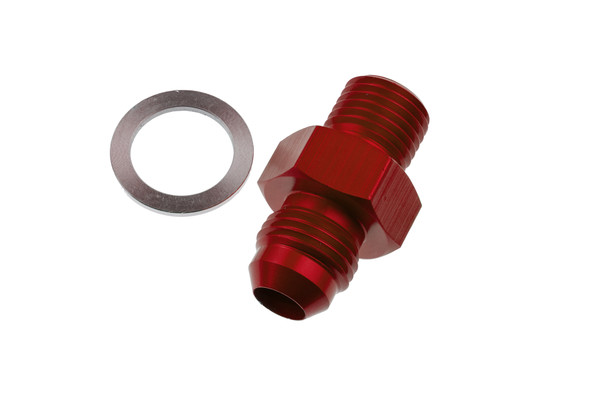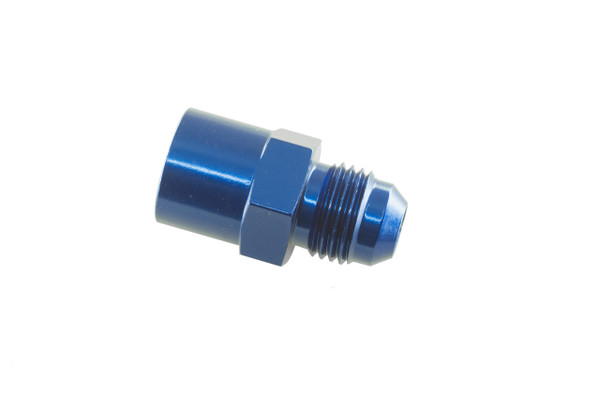The Ultimate Guide to AN Fittings
Aug 14th 2025
AN fittings represent the gold standard in fluid connections for high-performance automotive applications. Originally developed for military aircraft, these precision-engineered fittings have become essential components in racing, custom builds, and performance modifications. AN fittings create reliable seals that withstand extreme pressures and temperatures, making them ideal for fuel systems, hydraulic systems, and other critical applications where leak-proof seals are paramount.
Why AN Fittings Are Popular in Performance Builds
Performance enthusiasts choose AN fittings for their unmatched reliability and versatility. Unlike traditional automotive fittings, AN fittings create a tight seal through precise machining tolerances and standardized specifications. This consistency ensures compatibility across manufacturers and applications, from fuel lines to transmission lines.

Understanding AN Fitting Sizes
How AN Sizes Are Measured
AN fitting sizes correspond to the outside diameter of the tubing they're designed to connect, measured in sixteenths of an inch. For example, a -6 AN fitting accommodates 6/16" (3/8") outside diameter tubing. This standardized system ensures consistent fitment across different manufacturers and applications.
The dash number system makes sizing straightforward once you understand the basics. A -8 AN fitting works with 8/16" (1/2") tubing, while a -10 AN fitting accommodates 10/16" (5/8") tubing. This logical progression continues throughout the entire AN sizing range.
Understanding proper sizing is crucial for maintaining optimal fluid flow and system pressure. Undersized fittings can create flow restrictions, while oversized fittings may not seal properly or fit within space constraints.
Common Size Chart for Quick Reference
Here's a quick reference for common AN fitting sizes and their corresponding measurements:
- -3 AN: 3/16" (4.8mm) tubing
- -4 AN: 1/4" (6.4mm) tubing
- -6 AN: 3/8" (9.5mm) tubing
- -8 AN: 1/2" (12.7mm) tubing
- -10 AN: 5/8" (15.9mm) tubing
- -12 AN: 3/4" (19.1mm) tubing
- -16 AN: 1" (25.4mm) tubing
This sizing system applies universally, whether you're working with fuel hoses, brake line AN fittings, or transmission AN fittings.
Types of AN Fittings Available
Straight,30°, 45°,60°, 90°,120°,150°, and 180° Angled Fittings
AN fittings come in various angles to accommodate different routing requirements. Straight fittings provide the most direct connection but may not fit in tight spaces. 45-degree fittings offer moderate direction changes while maintaining good flow characteristics. 90-degree fittings allow sharp direction changes, perfect for tight routing situations or when connecting to components at right angles.
The 180-degree fitting, while less common, proves invaluable for specialized applications where complete direction reversal is needed. Each angle configuration maintains the same sealing integrity and flow capacity as straight fittings when properly installed.
Male vs. Female Fittings
Male AN fittings feature external threads and are typically used on hose ends, while female fittings have internal threads and often serve as ports on components or bulkhead connections. Understanding this distinction is crucial for proper system design and parts ordering.

Many applications require a combination of male and female fittings to create complete connections. The standard 37° flareensures reliable mating between quality components from different manufacturers.
Swivel vs. Non-Swivel Ends
Swivel hose ends allow rotation after installation, making it easier to align fittings and reduce stress on hoses during assembly. Non-swivel ends, while less expensive, require more careful planning during installation to achieve proper alignment.
Swivel ends prove particularly valuable in racing applications where frequent maintenance and reconfiguration occur. The ability to rotate fittings without disturbing the entire assembly saves time and reduces wear on components.
Specialty Adapters and Couplers
AN fitting systems include numerous specialty components like an fitting caps for sealing unused ports, adapters for converting between AN and national pipe thread connections, and couplers for joining different hose sections. These components expand the versatility of AN systems and enable integration with existing equipment.
Specialty adapters allow AN systems to interface with traditional automotive components, while quick-disconnect couplers facilitate rapid servicing in racing applications.
Materials and Finishes
Aluminum vs. Stainless Steel AN Fittings
Aluminum AN fittings offer excellent strength-to-weight ratios and are ideal for most automotive applications. They machine easily, allowing for precise tolerances that ensure reliable seals. Aluminum fittings work well with fuel systems, oil systems, and most hydraulic applications.
Stainless steel AN fittings provide superior corrosion resistance and strength, making them ideal for marine applications, brake systems, and other demanding environments. While heavier than aluminum, stainless steel fittings offer unmatched durability in corrosive conditions.
Benefits of Hard Anodized and Colored Finishes
Hard anodizing increases surface hardness and corrosion resistance while providing attractive finish options. Colored anodizing allows system identification through color coding - blue for fuel lines, red for oil systems, or black for general applications. These finishes also resist scratching and maintain their appearance over time.
Quality anodized finishes protect the base metal while adding visual appeal to engine bays and racing applications where appearance matters as much as performance.
Corrosion Resistance and Performance Considerations
Proper material selection ensures long-term reliability in specific applications. Marine environments require stainless steel or heavily anodized aluminum to resist salt corrosion. Racing applications benefit from lightweight aluminum with hard anodizing for durability without weight penalties.
Temperature considerations also influence material choice, with stainless steel better suited for high-temperature applications like turbocharger oil lines or exhaust-heated areas.
Choosing the Right AN Fittings for Your Application
Fuel, Oil, Water, and Transmission Lines
Each fluid system has specific requirements that influence fitting selection. Fuel systems require fittings compatible with modern ethanol-blended fuels and resistant to fuel additives. Oil systems need fittings that handle temperature extremes and maintain seals under varying pressure conditions.
Water systems, including cooling and methanol injection, require corrosion-resistant materials that won't contaminate the fluid. Transmission AN fittings must handle both hydraulic pressure and temperature cycles while maintaining precise tolerances for proper transmission operation.
High-Pressure vs. Low-Pressure Systems
High pressure applications demand fittings with superior sealing capability and structural strength. Power steering systems, hydraulic clutch lines, and forced induction applications require fittings rated for sustained high pressures without leakage or failure.
Low-pressure systems like return lines or vent systems can use lighter-duty fittings while still maintaining the reliability and appearance benefits of AN connections.
Compatibility with Hose Types (PTFE, Rubber, Nylon)
Different hose materials require compatible fittings for proper sealing and performance. PTFE hoses offer superior chemical resistance and temperature capability but require specific hose ends designed for their unique characteristics. Rubber hoses provide flexibility and cost-effectiveness for many applications.
Braided hose constructions add burst strength and abrasion resistance, making them ideal for racing applications where hoses may contact sharp edges or experience high pressures.
Benefits of Using Redhorse Performance AN Fittings
Engineered for Strength and Style
Redhorse Performance AN fittings combine precision engineering with attractive aesthetics. Each fitting undergoes rigorous testing to ensure it meets or exceeds industry standards for strength, sealing, and durability. The attention to detail in manufacturing shows in the consistent quality and reliable performance.
Design elements like smooth radius transitions and optimized flow paths maximize performance while maintaining the classic AN fitting appearance that enthusiasts appreciate.
Trusted by Racers and Enthusiasts Worldwide
Professional racing teams and serious enthusiasts choose Redhorse Performance fittings for their proven reliability under extreme conditions. From drag racing to road racing, these fittings have demonstrated their ability to perform when failure isn't an option.
Quality Control and USA-Based Manufacturing
Domestic manufacturing allows strict quality control throughout the production process. Each fitting is inspected to ensure proper dimensions, surface finish, and sealing capability. This attention to quality eliminates the inconsistencies often found in imported components.
USA-based manufacturing also ensures rapid availability and technical support when needed, crucial factors for racing teams and professional builders working under tight deadlines.
AN Fittings Maintenance and Troubleshooting
Checking for Wear or Leaks
Regular inspection of AN fittings prevents small issues from becoming major problems. Look for signs of fluid seepage around connections, discoloration indicating overheating, or visible wear on sealing surfaces. Early detection allows preventive maintenance before failures occur.
Replacing or Retightening Components
Proper torque specifications ensure reliable sealing without damaging components. Over-tightening can distort sealing surfaces or crack fittings, while under-tightening allows leaks. Use appropriate tools and follow manufacturer recommendations for installation torque.
When replacing fittings, inspect mating surfaces for damage and clean thoroughly before installation. Replace any components showing wear or damage to maintain system integrity.
Best Practices for Long-Term Performance
Protect AN fittings from physical damage during installation and service. Use proper support brackets to prevent stress on connections, and route hoses to minimize exposure to heat, sharp edges, or moving components.
Periodic system flushing removes contaminants that could affect sealing or cause corrosion. Document fitting locations and specifications for future maintenance, especially in complex systems with multiple connection types.
Conclusion
Investing in premium AN fittings like those from Redhorse Performance ensures your projects benefit from proven engineering, superior materials, and manufacturing excellence. The combination of performance, reliability, and aesthetic appeal makes AN fittings the preferred choice for enthusiasts and professionals who demand the best from their fluid systems.
